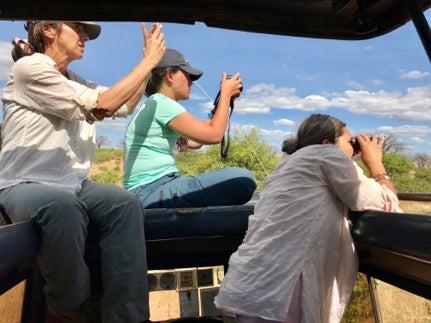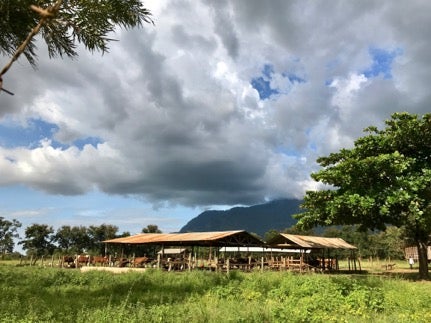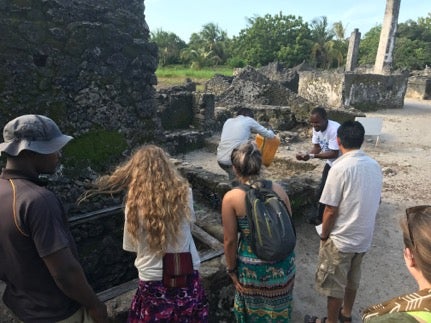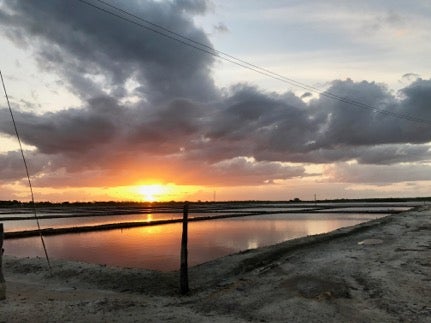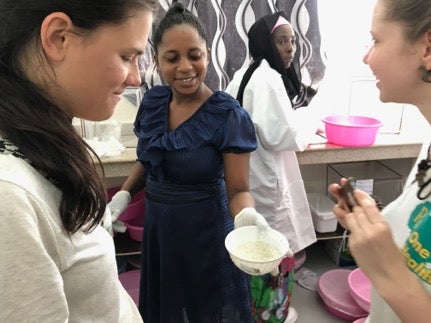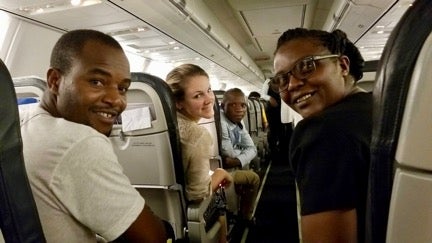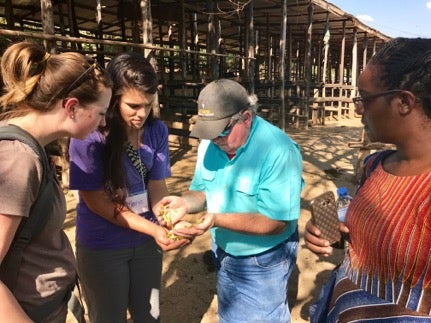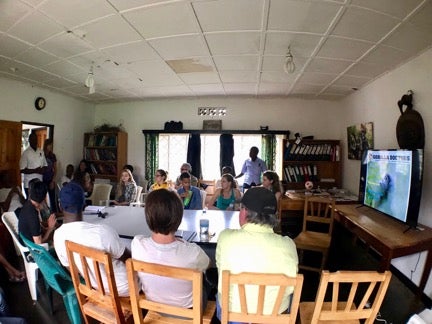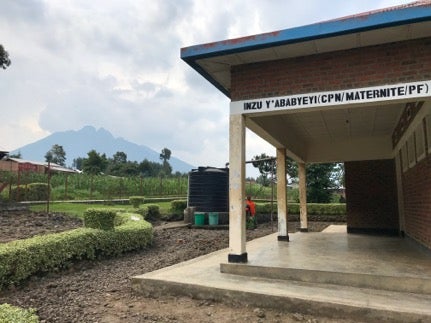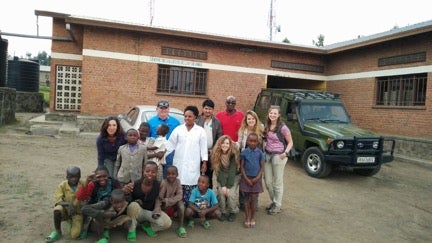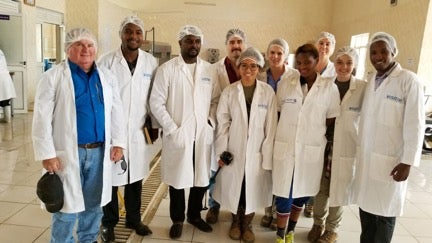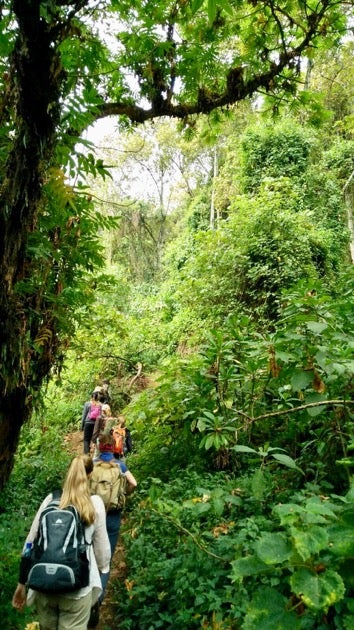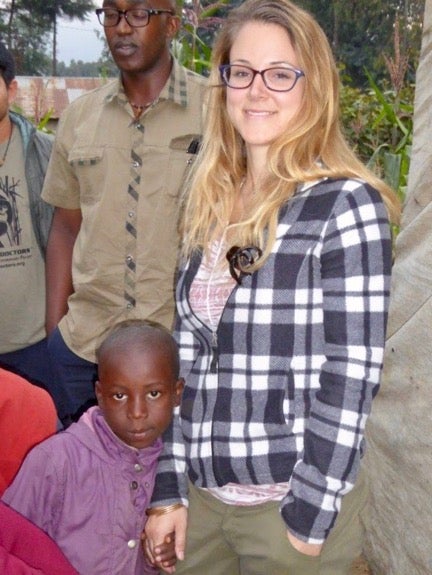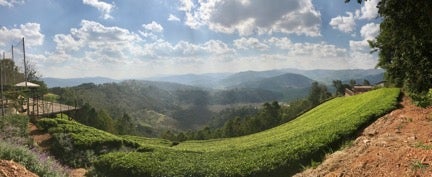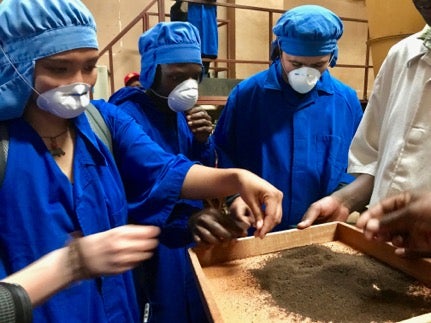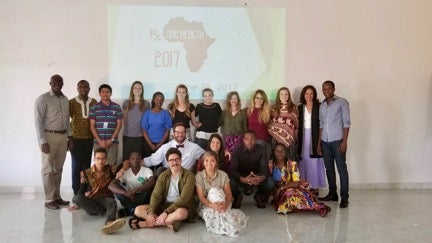Taylor Calloway (Class of 2018) was one of twenty-one students who participated in the new Rx One Health Course based in Tanzania and Rwanda during June 2017. This is Taylor’s personal narrative aiming to illustrate her daily experiences, a deeper understanding of the One Health approach in a real-world setting, and the big question of “why is this course important.”
Taylor’s journey Part III
06/13/2017
After a discussion about the ecology of the environment possibly effecting the Cape Buffalo populations and disease ecology of the giraffe skin disease, we ate breakfast and headed out of Ruaha National Park. We ventured to Idodi Health Clinic that works on a project with Rift Valley Fever and Brucellosis surveillance in the area. It was considered the nicest health clinics in Iringa. The clinic creates a large impact on community health by maintaining supplies, having organized areas of disease screening, and pregnancy/labor assistance specific areas.
Our driver told us a story about a mountain range outside of Ruaha. He explained that the Hehe would journey over the top to be blessed with pregnancy. This is because it looks like a woman lying down on her back with a pregnant belly. I proceeded to tell him that we are not allowed to cross over the mountain range for a long time.
Once back in Iringa we went shopping. I bought many gifts … ones that might end up being just for me. I grew closer to a couple people on the trip, exchanging stories and laughing for hours. I hope that we all stay in contact long after the course ends.
Kalenga kelu (Whehe word) mountain for the gift of pregnancy (meaning clear water).
06/14/2017
Our day started with us running late. About two hours late. Which meant our eight-hour ride to Bagamoyo, a coastal town by Zanzabar, ended at 9:30 pm. So it was a long car day to say the least.
We were able to stop briefly in Morogoro to tour Sokoine University of Agriculture. We spoke with apopo, rat, tuberculosis laboratory about their African burrowing rat training program to identify TB from human sputum. All of the veterinary students almost stole the rats, they were adorable and showed off their intelligence when we saw training demonstrations. (Side note: you can support one of these rats and the program will send you notices on how they are doing. Great present idea for the activists and animal lovers in your life. No they did not pay me to tell you this. I just really loved the rats!) Then we spoke with Dr. Abel Ekiri about the HALI project’s virology lab, which was recently made out of two shipping containers. It was housed with technology we use at UC Davis and flowed in a way that was organized and really made sense.
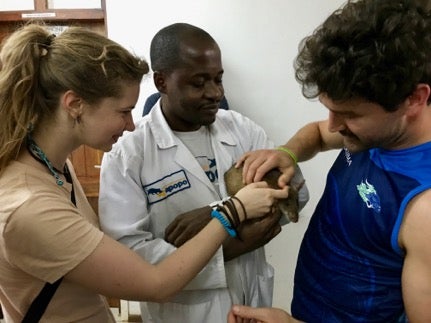
Maria Ertner and Nathan Brown getting their animal time in before the African burrowing rat demonstrates the TB detection process.
It was a good day of getting to know the people in our cars, and learning how long we can hold it before short calls need to be made! Maria and I exchanged music so I will go home with a list of new songs to buy. We just arrived in Bagomoyo. I have eaten and now I am exhausted. Lala salama!
Tanzanian Gold is the phrase used when the locals refer to their country’s wildlife. That alone speaks volumes to the pride shown by the citizens of Tanzania. My dream is to see that type of feeling fill the minds of more people in the United States. Life would be much more beautiful.
06/15/2017
Lay down your heart. Bagamoyo, the sorrowful name was given to this town during the time of slave trading. Originally a trading entrepot for fish, salt and other goods, in the early 19th century the port began to focus on ivory and slave trade to Zanzibar and onward. Now, the town is a beautiful coastal town with many nice locals, but you can feel the tinge of sadness when visiting the monuments and gravesites. The pride that the locals showed when explaining their history was moving and gave me a feeling of optimism. Even a beautiful place can come from the death of a dreadful situation.
Sadly (too many sad things today!) we had to say goodbye, for now, to a strong, extremely intelligent, driven, and yet, humble and hilarious individual, Dr. Jonna Mazet. It was really interesting and inspiring to get to know her. I look forward to working with her in the future. Before she left, she gave a great overview lecture about outbreak investigation, and how to approach it from an epidemiologic standpoint.

The day the team said ‘goodbye for now’ to Dr. Mazet.
Top Left to Right: Bashayija Winnie, Alessandra Amadeo, Courtney Youngbar, Taylor Calloway, Majyambere Denis, Jonna Mazet, June Barerra, Santosh Dulal, Adrien Emile Ntwali, Sophie Charlton, Nathan Brown.
Bottom Left to Right: Ntakiyisumba Eulade, Ian Trupin, Marie Bosch, Katya Luckenbach, Muhizi Karinda Serge, Taylor Young, Maria Ertner.
In her place, Dr. Brian Bird, UC Davis, joined our team. He has many stories about life and working with the United States Center for Disease Control (CDC). This, along with making me laugh the first time I spoke with him, has me looking forward to getting to know him.
Vitumbua: an amazing coconut rice poofy pancake. Try it sometime!
06/16/2017
We were able to visit the Ifakara Health Institute, IHI, in Bagamoyo. They conduct research in malaria and HIV/AIDS. They are considered one of the largest institutes for malaria in the world. It was wonderful to hang out with mosquitos and the people who spend their time and energy to impact the world of infectious disease.
Next we toured a Biosafety 3 lab. Dr. Bird was extremely helpful in explaining the types of biosafety labs and how they function. Unfortunately, his great explanations and good humor couldn’t stop the immense heat we were experiencing during the tour. Pretty sure I found sweat pores I never noticed before. Yes gross. It’s ok; at that point I didn’t care and neither did anyone else.
The heat decided to stay with us for the rest of the day. The afternoon was spent with malaria vaccination lectures and sweat. Again, we were all in the same boat, it was just filled with our sweat. Ok, ok, I am done being gross.
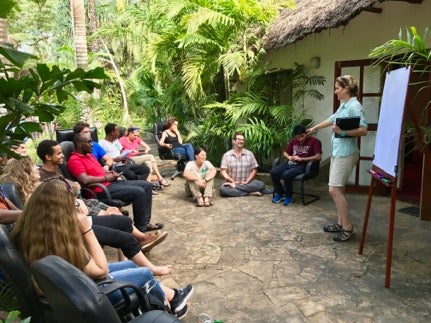
Amanda Mackenzie leading our group in a discussion about mental health across our different cultures.
Our group moved outside for a mental health lecture led by Amanda Mackenzie. It was a great way to learn about other cultures from around the world. We discussed how to interact with one another and the differences between mental health and mental illness. I was happy to feel connected to those who chose to open up about their own mental health. It also sparked a connecting conversation between Marie and me. Later, other conversations with Marie, Maria and Courtney really moved me. I was able to feel very centered and grounded and I am happy to say that they are friends I would call at 3:00 am with any problem. Beer was involved at some point, which might have helped.
Swahili Word of the Day: Samahani, Sorry.
06/17/2017
Finally Dr. Bird lectured us. I was on the edge of my seat while he spent the morning talking about his work with the Ebola outbreak in West Africa. He incorporated outbreak logistics and personal touching times that had tears forming in my eyes. I applaud him.
In the afternoon, Amanda and Dr. Bird had us perform an outbreak scenario in small groups. We all enjoyed this type of learning style and I actually remember everything taught to us through this. After, each group had a leader talk to the entire group in a panel form. If I was a professor, this is exactly how I would try to teach. It was engaging and informative. I will remember what I learned today for years to come. Maybe it will help me decide what I want as a niche in my career.
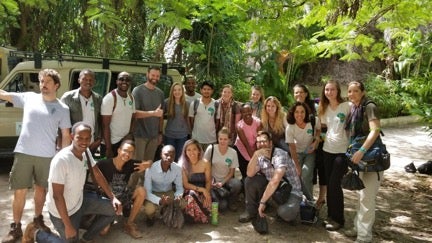
Saying goodbye for now to Dr. Bird.
Top Left to Right: Nathan Brown, Adrien Emile Ntwali, Majyambere Denis, Brian Bird, Katya Luckenbach, Lupayani Mwokozi Mwanzalila, Santosh Dulal, Courtney Youngbar, Marie Bosch, Alessandra Amadeo, Sophie Charlton, Amanda Mackenzie.
Bottom Left to Right: Muhizi Karinda Serge, Ian Trupin, Ntakiyisumba Eulade, June Barerra, Taylor Young, Eric Shmowlette.
Amanda and I had a touching conversation about the good and ugly of life. I felt extremely supported by her and aspire to be like her in compassion, empathy, and strength. If anything, my time in Tanzania has given me close mentorship I would have never experienced otherwise. For that I am extremely grateful.
Swahili Word of the Day: Mbwa, dog.
06/18/2017 & 06/19/2017
So you know how things never go as planned? Yeah, sitting on a plane for three hours, not moving at all was not our initial plan.
The day started out great. A walk on the beach. Talking with beautiful people. Being serenaded by a mandolin…. Hmmm… All I needed was a margarita. We left for the airport around noon for a 5:30 pm flight. Everything went smoothly until the captain told us there was a mechanical issue and to remain seated. I pulled out my book, “The Handmaid’s Tale” and waited. Eulade was sitting in front of me and wanted to know what the book was about. I gave it to him to read the back. He didn’t understand fully, thus being the amazing friend I am, I read it to him and explained any words he didn’t know. Come to find out, saying ovaries out loud on a plane is met with eye rolls and weird looks from other passengers. Oh well, can’t please them all. But Eulade was happy and that is what matters.
After almost three hours, we were escorted off the plane, driven to a hotel and slept for two hours before returning to the airport at 3:00 am for the next flight out.
I definitely have a newfound appreciation for my group here. Once we arrived in Kigali, Rwanda, we were swept away to the University of Rwanda College of Science and Technology and lectured at (with breakfast and coffee) until the afternoon. Those lectures could not be rescheduled. Yes it was difficult, but those of us who were falling asleep in our chairs stood in the back of the room to remain attentive. After that, we were given the afternoon off.
I did try to sleep for a bit and then went to the pool to hang out with friends and laugh at an amazingly horrible joke battle that Marie and Nathan Brown, from UC Davis, threw down. I don’t know how they remember any of those.
Why did the farmer win an award?
Because he was outstanding in his field!
Cheesy beyond compare, yes we know.
Kinyarwanda Word of the Day: Kwidagadura, to enjoy one’s self.
06/20/2017
Back at the University of Rwanda College of Science and Technology we were exposed to a few more lectures about food safety, wildlife conservations and tourism, and Phil Cotton, the Vice Chancellor of the university, gave us a brief talk about the future or the school.
The most enticing part of today was the dairy visits. Even though they were rushed, because of time constraints, the farmers were helpful and answered any questions we had. Of course I had a ton more questions but felt as though they were more specific questions versus broad overview, which is what the visits were suppose to highlight for the entire group. However, I still learned a good amount talking with Dr. Jim Cullor from UC Davis and the translators for the farmers. Everyone needs a little more ‘moo’ in their lives anyway, so it was fun to see everyone’s smiling faces.
Tonight I needed time to be an introvert and power up. It was nice to talk with some people but then I sat in bed and read my book.
Kinyarwanda Word of the Day: Murakoze, thank you.
06/21/2017
We drove up to Ruhengerito and had lunch at Gorilla Doctors Head Quarters. Together we met with Dr. Noheri or Noel and discussed common issues with the National Park. Apparently, after trauma, viral respiratory diseases contracted from humans are a huge reason gorillas contract secondary bacterial diseases, become ill and die. There was also discussion on the close contact that the villages have with the gorillas and the impact of tourism in the area… there was also three adorable dogs, two puppies, which joined us. We all needed that puppy love!
After lunch, we traveled to Le Bambou Gorilla Lodge in Kinigi. This place is special. There are beautiful lounge areas with comfy couches and fireplaces in the middle of the room. Dr. Bethany Hendricks from UC Davis spoke with us about the microbiome of infants and children in one of these lounge areas. It was extremely interesting to learn how different countries contain different microbiomes because of breast milk and bovine milk oligosaccharides. If you are interested, you should look her up. She is extremely impressive.
Then we were led to a surprise on the lawn facing the volcanoes. An hour-long entertainment session was planned with traditional Rwandan dancing. There were drums and bells tied around the dancers’ ankles. Vibrations from the drums and dancers’ rhythmic stomps could be felt through the ground as I sat on the grass to watch and record the performances. The dancers even pulled us up into the group to teach us. It was amazing! I am still smiling from it.
Dinner was amazing. There was a check in discussion about pros and changes for the course so far, which was really helpful. I believe we all really felt heard and could openly talk about what might be bothering us. Now we are all hanging out by the fireplace with some cards and Ian’s mandolin. So I am making this short so I can keep up with my friends. Bye or mulabeho in Kinyarwandan!
Kinyarwanda Words of the Day: Muraho, what’s up; Ingagi, gorilla.
06/22/2017
Lets implement a One Health approach to the community of Kinigi! So easy right? Wrong… not only are there human-animal conflicts with the national park and adjacent farmlands; there are issues with the community’s economy, society’s health, poaching, diseases (including rabies, brucellosis, tick-borne diseases), dairy management/health, medical communication, education (in multiple realms), nutrition, and many other areas. Although the list can go on, the community’s list of ideas to improve their village plus their passion to do so is infectious! I am excited to learn more from them and find out what exactly they want.

A smaller group of our team talking with a local Community Healthcare Worker about the village she helps in.
In a small group we traveled to the local health center. The main issues they said they had were transportation (one ambulance for three health centers), funding (only half their staff was employed by the health center, other half by the government), and advanced education (majority of employees only have a high school education, even nurses). Then we traveled to a community health worker’s home and asked her questions. Apparently, these are health leaders in different districts that give ‘at home care’ for people. This includes: medications for malaria, contraceptives, maternity care, and general treatments for sickness. She indicated that she would like more education on animal health so she can talk to her families about zoonotic diseases and how to care for their small farms.
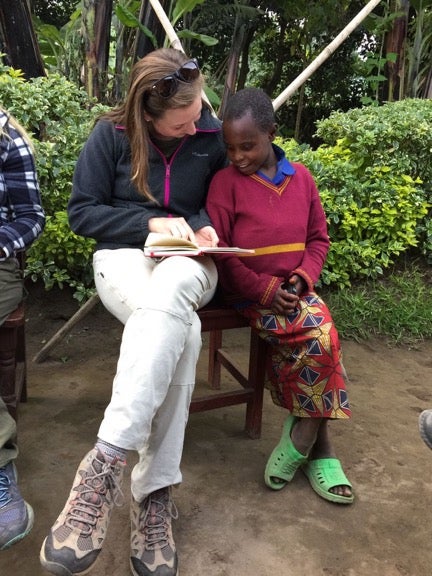
Courtney Youngbar and a young child learning from each other. As Dr. Cullor says “Its all about the children!”
We met a bunch of community children. They were delighted to see us and tried out their English while we spoke in broken Kinyarwanda. They would laugh at us, hold our hands and draw us pictures. It was nice to pretend to be a kid again with them. We all needed that today.
By the way, we are going around the community to pick up more information for a One Health approach for Kinigi to present to governmental officials. They apparently really want our input… I am sure we will have plenty of ideas by the end of our research. It is exciting knowing that we might actually have an impact on a community. Now, I just look forward to coming up with sustainable ideas that the community members actually want long term.
Kinyarwanda Word of the Day: Inshuti, friend.
06/23/2017
There is so much to write down and most of it I don’t know how to explain. Today was a learning adventure. A small group of us showed up at the Volcanoes National Park in the morning. We discussed with the park manager, head veterinarian, Rwandan development board (works with the stakeholders of tourism), and the head of conservation research with the Dian Fossey Gorilla fund. The head of the conservation research, Felix Ndagijimana, was in The Gorilla King movie from last night. So I met a celebrity, feel jealous…
For those of you that don’t know, mountain gorillas are the pride of Rwanda. They are a subspecies of the eastern gorilla, and only found in the Virunga volcanic mountains located in Uganda, Rwanda and the Democratic Republic of Congo. Dian Fossey was the first researcher to habituate the mountain gorillas in Rwanda around 1967. She started a fund after her favorite silver back (mature male), Digit, after his murder in 1977. Fossey was murdered in 1985 and the fund’s name was changed to Dian Fossey’s Gorilla fund. But why am I telling you all of this? Stop being lazy and go read her book Gorillas in the Mist.
There are many efforts to continue conservation of the mountain gorilla population in Rwanda. These efforts need to be balanced with tourism to help fund the park and begin community opportunities throughout Rwanda. So you can see the slight dilemma. If you can’t, the simple answer is: conservation and tourism walk a fine line when working together. It is difficult to find a balance between how many people should enter the park, the disease protocols, the amount of contact with the gorillas, and cost to trek with gorillas. Other than tourist, there are also researchers and park rangers that move through the park to keep this umbrella, key species surviving. Then, with the positive increase in gorilla numbers, comes ecosystem health, the idea of maximum capacity of animals in the park, and the other species that can only be found in this specific park. As a small group, we discussed many of these issues and others including feral dog problems, wild animal crop raiding and human conflict, and funding for Rwandan residents to see the national park.
I learned that there are always more questions. And there is never enough time for them all.
Got milk? Well the community in and around Kinigi wishes they had more. We met with a local cow farmer… when I say farmer, I am two cows… which is well off in this area. There is a program in Rwanda where every family is allowed a dairy cow supplied by the government to help with child nutrition. The idea is great on paper. However, it comes with some extra problems. One being proper nutrition for the cows, time and money spent taking care of the cows, mastitis, other diseases (zoonotic included) and proper hygiene practices.
Boards question: How long and at what temperature do you have to boil raw milk for?
Answer: 140 degrees Fahrenheit for 30 minutes.
After asking her if she liked what she did, she smile and told us that she loved being a farmer for her 9 children. (Can you imagine?! Nine!!). She did wish that teat dips were cheaper than paying for antibiotics for mastitis and for more milk production to sell to the community milk collection center for money. (This is an issue too because you can get more money directly by selling raw milk to your community than selling to the center… can you say disease spread?)
After we went to the community milk collection center and then to a milk processing plant. The ideas are great and with a little more education and money, the centers can succeed. This will help the nutrition of the community and hopefully bring in money to the villages.
I went to bed early after all of this commotion. After a ton of information, you need to process in your sleep.
Kinyarwanda Word of the Day: Inka, cow.
06/24/2017
“Shall we point our toes down?” Our guide questioned after we stood in silence around Dian Fossey’s gravesite. Our day off started with a trek up to the beloved researcher’s gravesite. Her story added with the relics from her time in the National park preserving and researching mountain gorillas was a good mental and physical experience for us all. Because I am always in a One Health mindset, the fact that village agricultural farmlands literally touch the park’s entry buffalo wall (I expected the wall to be a legit 12 foot tall wall, but in reality is a three foot stone hedge that would never keep animals in or poachers out). Anyways, that’s an area for improvement, but as we are all discovering, every solution comes with many more issues to address.
The hike was gorgeous. It was a cool, 50 degree, day with beautiful greenery surrounded by dark towering volcanoes and rolling hills. We took a ton of pictures and whispered so we wouldn’t scare wildlife.
In the afternoon, a couple of us went to the market to buy gifts. After the market I discovered a little voice inside my head saying, ‘donate a ton of clothes before you leave Rwanda and then more when you get home’. I am not a minimalist by any means but this trip has taught me what I can live without, and that is a lot of stuff. Then we were given the rest of the day off. So I caught up on this blog!
Kinyarwandan Word of the Day: Meze Neza, I am very great!
06/25/2017
Back to the grind (dun dun dun! Music playing).
We began with lectures that made you think more deeply about implementation, sustainability and efficacy of a large scale international project. Our steps need to be: 1- empathize, 2- define, 3- ideate, 4-prototype, 5-test. It all seems straight forward, but after sharing with my colleagues, we discovered how quickly a project could fall apart. One example explained how a great idea was brought into a new area, yet after tireless hours working to implement it, it fell through because no one in that area really felt the need for the project. Another example showed that without asking the local community what they needed, the projected centered on what the project leaders thought would be helpful. Although the ideas would have been helpful for the community long term, it is not what the community really wanted, so it fell through.
I have listened to many mentors tell me this in my academic career. However, every time I am reminded to empathize in the beginning of the project, it always shocks me that I started with step two. One day it will stick!
We ventured to an 800-meter area from the park. This is where the government is implementing a proposed buffer zone. Side note, it is probably one of the most beautiful places I have ever visited. At first it was difficult for me to jump on board with the buffer zone idea as people are living and farming on the land. That is their livelihood and the government is about to move them. I am hoping to ask more about this later. As a group, we discussed possibilities for this area keeping in mind all the problems that might impact conservation, tourism and the community.
We discussed the idea of a rotary, enclosed, co-op dairy, aquaculture system for water outflow, solar panels, and trade school for the community. Other ideas were thrown out there and hopefully we can all agree on some in the next couple days.
After dinner we watched a documentary about the Rwandan cycling team called “Rising from Ashes”. Unfortunately, my GI tract decided to throw a party and I missed some of it. What I did see was inspiring and it talked a bit about the genocide. If you like bikes or feel good stories, watch it.
Kinyarwanda Word of the Day: Keza, beautiful girl. (My nickname in Kiyarwanda).
06/26/2017
More field investigations today. This is the kind of thing I have learned to like. Even though the end of the day catches up with you quickly, listening to stakeholders talk about their needs and wants for their own prosperity is mind opening. First we spoke with two different health workers in their communities. One specialized in disease control and preventative health, while the other helped women with maternity and postnatal care. It was interesting to hear how little they are composited. After being ask what they would want to help their communities, they both said education. One wanted education in animal welfare and zoonotic disease. The other said classes in arts and crafts would help the community by producing a product for tourist to buy, brining more money into the community’s pockets. It’s great to see the women happy; they can make an influence and have importance in the community.
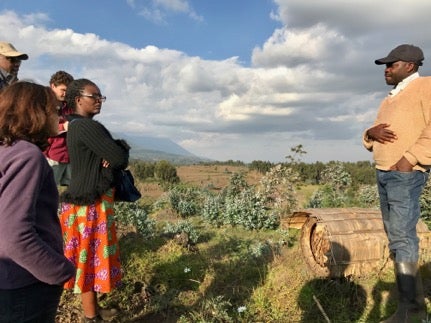
Speaking with a reformed poacher about his view on the buffer zone and how he stops poaching and raiding of the national park by humans. Local bee hive can be viewed in the picture.
Once we took pictures with the health workers. Our group was on its way to talk with a reformed poacher that is now helping the national park take out traps and stop poaching and raiding practices. He understood that a buffer zone was being produced. He showed us how close farming huts are to the buffalo wall and where buffalo, gorillas, golden monkeys, and elephants had destroyed crops. He was especially worried about the park buffalo that would eat anything and came over the wall more often. Once we talked about more personal ideas he had, he expressed that the buffer zone should be an expansion of the park and a better wall should be made. He was aware he and other people would have to move off of the land they now used for their livelihood, but he was very conscious that the gorilla tourism was the main moneymaker for the community.
This made things difficult for us. Once we went back to our lodging, we all had a discussion and tried to figure out what big challenges were with the communities. Then we set a time for tomorrow night to come up with ten main One Health challenges from the information we collected.
Tonight ended with a guitar, some singing, good food and drinks. You could see exhaustion in everyone’s eyes but they didn’t stop the laughter. I am pretty sure that is one of my favorite parts of this trip. The laughs.
Kinyarwanda Words of the Day: Yego, yes; Oya, no.
One time this week we asked to take pictures with some children, they laughed and said what sounded like, “oh yeah”… We soon discovered this actually means no.
06/27/2017
Travel day! We went back to Kigali with a pit stop at Sorwathe Tea Plantation. We were given a tour of how black and green teas are made in the processing plant. Then they fed us lunch on a beautiful balcony area that overlooked plantations, fields and fields of green. It was great to meet the owner who was originally from Sri Lanka. I got to talk with him a little bit about my experiences there. It was nice to remember the good times in Sri Lanka while in Rwanda.
It took us much longer to get to the Nobleza Hotel then thought, so we rescheduled our grey-crowned crane lecture. Once we finished dinner, we met up and discussed the challenges and positive features of the community we were working with. The lists were both very long (not ten challenges). As we were extremely tired, we decided to find the most important challenges and group some of them together tomorrow morning.
We meet at eight to begin our full day of project planning for the Kinigi community challenges.
Kinyarwanda Word of the Day: Nitwa, my name is/I go by
06/28/2017
With help from our instructors we began at 8 am and worked until about 7 pm. We needed to figure out the main One Health challenges, and roles in our own team. We split into smaller groups to tackle challenges, and produced ideas to form into a presentation for the following day. It was a lot in one day but I am proud to say that we worked together well and all agreed on most items to present tomorrow.
Our big idea was to split the presentation into four main categories that included: the barrier, the buffer zone, the dairy co-op, and education/tourism/community health workers.
Each small group took on these individual categories and looked at the challenges presented, found solutions and talked about these in their own PowerPoint slides. At the end, we presented to each other, made edits and asked questions to the group as a whole. Then we placed the presentation into first the idea of a dairy co-op, then the barrier, followed by the buffer zone and finally the education/tourism/community health workers future plans.
There were many interesting and helpful ideas that came from our brainstorming and I am happy to say that we all were efficient and effective at executing the presentation.
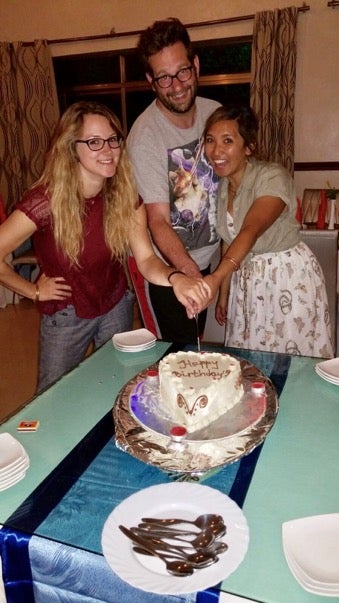
Cutting our cake! Taylor Calloway (June 30th), Eric Schmowlette (June 4th) and June Barrera (June 11th).
By the end of the night, the presentation looked great and we were ready for bed.
Kinyarwanda Word of the Day: Ndagukunda, I love you/I like you

